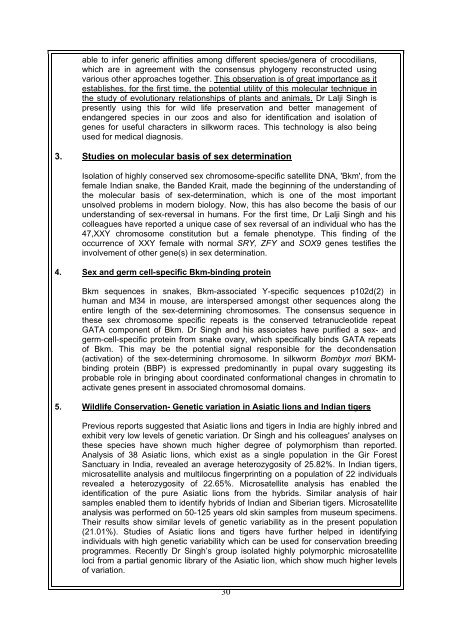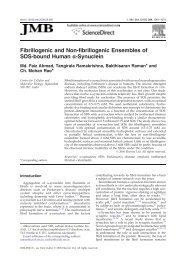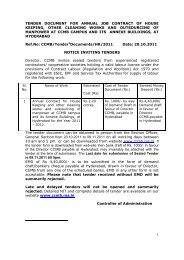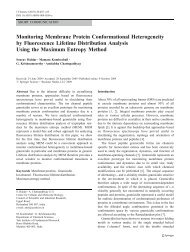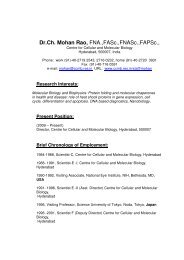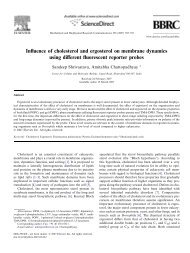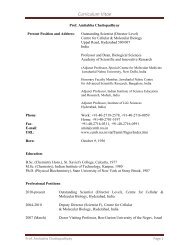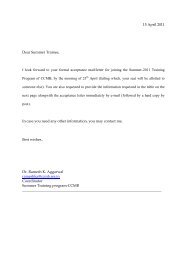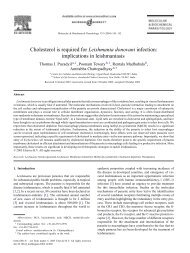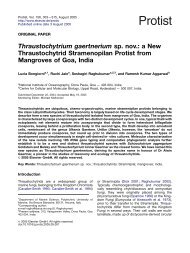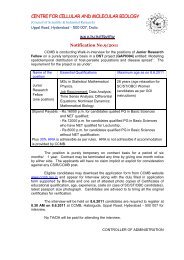Dr Lalji Singh - CCMB
Dr Lalji Singh - CCMB
Dr Lalji Singh - CCMB
Create successful ePaper yourself
Turn your PDF publications into a flip-book with our unique Google optimized e-Paper software.
able to infer generic affinities among different species/genera of crocodilians,<br />
which are in agreement with the consensus phylogeny reconstructed using<br />
various other approaches together. This observation is of great importance as it<br />
establishes, for the first time, the potential utility of this molecular technique in<br />
the study of evolutionary relationships of plants and animals. <strong>Dr</strong> <strong>Lalji</strong> <strong>Singh</strong> is<br />
presently using this for wild life preservation and better management of<br />
endangered species in our zoos and also for identification and isolation of<br />
genes for useful characters in silkworm races. This technology is also being<br />
used for medical diagnosis.<br />
3. Studies on molecular basis of sex determination<br />
Isolation of highly conserved sex chromosome-specific satellite DNA, 'Bkm', from the<br />
female Indian snake, the Banded Krait, made the beginning of the understanding of<br />
the molecular basis of sex-determination, which is one of the most important<br />
unsolved problems in modern biology. Now, this has also become the basis of our<br />
understanding of sex-reversal in humans. For the first time, <strong>Dr</strong> <strong>Lalji</strong> <strong>Singh</strong> and his<br />
colleagues have reported a unique case of sex reversal of an individual who has the<br />
47,XXY chromosome constitution but a female phenotype. This finding of the<br />
occurrence of XXY female with normal SRY, ZFY and SOX9 genes testifies the<br />
involvement of other gene(s) in sex determination.<br />
4. Sex and germ cell-specific Bkm-binding protein<br />
Bkm sequences in snakes, Bkm-associated Y-specific sequences p102d(2) in<br />
human and M34 in mouse, are interspersed amongst other sequences along the<br />
entire length of the sex-determining chromosomes. The consensus sequence in<br />
these sex chromosome specific repeats is the conserved tetranucleotide repeat<br />
GATA component of Bkm. <strong>Dr</strong> <strong>Singh</strong> and his associates have purified a sex- and<br />
germ-cell-specific protein from snake ovary, which specifically binds GATA repeats<br />
of Bkm. This may be the potential signal responsible for the decondensation<br />
(activation) of the sex-determining chromosome. In silkworm Bombyx mori BKMbinding<br />
protein (BBP) is expressed predominantly in pupal ovary suggesting its<br />
probable role in bringing about coordinated conformational changes in chromatin to<br />
activate genes present in associated chromosomal domains.<br />
5. Wildlife Conservation- Genetic variation in Asiatic lions and Indian tigers<br />
Previous reports suggested that Asiatic lions and tigers in India are highly inbred and<br />
exhibit very low levels of genetic variation. <strong>Dr</strong> <strong>Singh</strong> and his colleagues' analyses on<br />
these species have shown much higher degree of polymorphism than reported.<br />
Analysis of 38 Asiatic lions, which exist as a single population in the Gir Forest<br />
Sanctuary in India, revealed an average heterozygosity of 25.82%. In Indian tigers,<br />
microsatellite analysis and multilocus fingerprinting on a population of 22 individuals<br />
revealed a heterozygosity of 22.65%. Microsatellite analysis has enabled the<br />
identification of the pure Asiatic lions from the hybrids. Similar analysis of hair<br />
samples enabled them to identify hybrids of Indian and Siberian tigers. Microsatellite<br />
analysis was performed on 50-125 years old skin samples from museum specimens.<br />
Their results show similar levels of genetic variability as in the present population<br />
(21.01%). Studies of Asiatic lions and tigers have further helped in identifying<br />
individuals with high genetic variability which can be used for conservation breeding<br />
programmes. Recently <strong>Dr</strong> <strong>Singh</strong>’s group isolated highly polymorphic microsatellite<br />
loci from a partial genomic library of the Asiatic lion, which show much higher levels<br />
of variation.<br />
30


